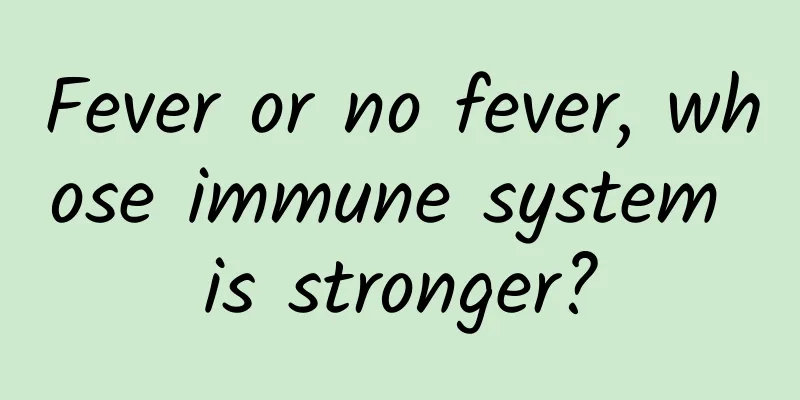How much do you know about facial neuritis, the "killer" of appearance? An article will help you understand it

|
Facial neuritis, also known as facial nerve palsy or Bell's palsy, is a neurological disease that is mainly manifested by paralysis or weakened facial muscles. The facial nerve is responsible for the movement and expression control of facial muscles. When the facial nerve is damaged or inflamed, it will lead to dysfunction of facial muscles. Experts from Yiyang Central Hospital said that facial neuritis can occur in any age group, but is more common in young and middle-aged people, and slightly more common in men than in women. The disease usually occurs on one side, and in a few cases both sides are affected at the same time. 1. Causes of facial neuritis The causes of facial neuritis are varied, including infection, trauma, autoimmune disease, tumor compression, etc. Among them, viral infection is one of the most common causes, such as herpes virus, influenza virus, etc. When these viruses invade the facial nerve, they can cause nerve inflammation and edema, leading to facial muscle dysfunction. In addition, factors such as cold face, fatigue, and mental stress may also induce facial neuritis. 2. Symptoms of facial neuritis Facial neuritis usually has an acute onset, and patients are often found to have crooked mouth and drooling when brushing their teeth and washing their face in the morning . It is often accompanied by pain in the mastoid area behind the ear, inside the ear, or at the angle of the mandible on the paralyzed side 1 to 3 days before the onset. 3. Pathogenesis of facial neuritis Facial neuritis mainly involves processes such as nerve ischemia, edema and compression . When the facial nerve is damaged or inflamed, the nerve fibers will swell and degenerate, resulting in obstruction of nerve conduction function. At the same time, the blood supply to the facial muscles will also be affected, further aggravating muscle dysfunction. The main manifestations are paralysis of the facial expression muscles on one side, disappearance of forehead wrinkles, inability to frown, enlarged palpebral fissure, inability to close or incomplete closure of the eyelids; eversion of the lower eyelid and overflow of tears; the eyeball on the paralyzed side rotates upward when the eyes are closed, exposing the white sclera; the nasolabial groove on the affected side becomes shallow, the corner of the mouth droops, and saliva flows out of the mouth; the corner of the mouth tilts toward the healthy side when the teeth are exposed; paralysis of the orbicularis oris muscle causes air leakage in the cheek or when whistling; paralysis of the buccinator muscle causes food to easily remain between the teeth and cheek on the affected side; some patients are found to have decreased taste in the anterior 2/3 of the tongue on the affected side, hyperacusis, pain in the external auditory canal and herpes during physical examination. 4. How to prevent facial neuritis 1. Avoid catching a cold, keep warm, keep your face warm during the autumn and winter seasons, and avoid direct exposure to cold water on your face; 2. Strengthen physical exercise to improve your immunity; 3. Avoid fatigue, pay attention to rest, and don’t stay up late; 4. In summer, it is not advisable to use air conditioners and fans at the same time for a long time, especially when the cool air blows directly on the head and face; 5. Eat a balanced diet and pay attention to nutritional balance. 5. How to treat facial neuritis Facial neuritis is a common neurological disease, and its treatment includes physical therapy, body therapy, acupuncture, drug therapy, and other treatments . 1. Physical therapy : In the acute stage, hot compress, infrared irradiation or short-wave diathermy is applied to the area near the stylomastoid foramen to promote local blood circulation and dissipation of inflammation. Iodine ion penetration therapy can be given during the recovery period to further promote the recovery of nerve function; 2. Physical therapy : Massage the paralyzed facial muscles several times a day for 5-10 minutes each time. When the nerve function begins to recover, the patient can practice the voluntary movement of each individual facial muscle of the paralyzed muscle in front of the mirror to promote the recovery of muscle function; 3. Acupuncture treatment : Acupuncture treatment has a certain effect on facial neuritis, which can stimulate acupoints and promote the recovery of nerve function; 4. Drug treatment : In the acute stage, short-term use of glucocorticoids such as prednisone may be effective and can reduce inflammation and edema. At the same time, neurotrophic drugs such as B vitamins and dimethoprim can also be used to promote nerve regeneration and functional recovery; 5. Other treatments : Use eye patches, eye drops, eye ointments, etc. to protect the exposed cornea from damage or infection, and prevent the paralyzed facial muscles from being overly pulled by the healthy muscles. Facial neuritis generally has a good prognosis, with about 80% of patients recovering within a few weeks or 1 to 2 months . Incomplete facial paralysis can recover or heal within 1 to 2 months, while complete facial paralysis generally takes 2 to 8 months or even 1 year to recover. The prognosis is poor and often leaves sequelae. If the patient has diabetes, hypertension, arteriosclerosis, myocardial infarction and other diseases, the prognosis will be poor. For patients with poor prognosis, early intervention and rehabilitation training are particularly important to minimize the impact of sequelae. References [1] Chinese Society of Neurology, Chinese Society of Neurology Neuromuscular Disease Group, Chinese Society of Neurology Electromyography and Clinical Neurophysiology Group. Chinese Guidelines for the Diagnosis and Treatment of Idiopathic Facial Paralysis[J]. Chinese Journal of Neurology, 2016, 49(2):84-86. [2] Ge Junbo, Xu Yongjian, Wang Chen. Internal Medicine (9th edition). People's Medical Publishing House. 2018, 40-42. [3] Wang Chen, Wang Jianan, et al. Internal Medicine (8-year system) [M]. 3rd edition. Beijing: People's Medical Publishing House, 2015: 15-17, 39, 42, 49, 132-134. [4] Jiang Xuexia, Yu Huimin, Liu Aijun, et al. Observation on the efficacy of acupuncture treatment of peripheral facial paralysis in 226 cases according to stage differentiation of syndromes [J]. Chinese Folk Therapy, 2017(11):25-26. [5] Li Zhen. Observation on the efficacy of acupuncture treatment of peripheral facial paralysis at different intervention times [J]. Guangming Traditional Chinese Medicine, 2014(6):1250-1251. [6] Gao Jie. Clinical nursing of facial nerve paralysis[J]. Chinese Medical Guide, 2017. (12). Hunan Medical Chat Special Author: Xiong Chuangyu from Yiyang Central Hospital Follow @湖南医聊 to get more health science information! (Edited by YH) |
<<: Exploring the future of sleep: the revolution in bionic sleep technology
>>: A small capsule that can sense your heartbeat at all times!
Recommend
Poor sleep after IVF
Every married couple hopes to have a baby of thei...
People who don't get seriously ill generally have these common characteristics! Many people can't do the first one!
Having a healthy body and being less sick is ever...
How to express milk after weaning
After weaning, sometimes milk problem will still ...
Pregnant woman's belly is itchy, will she give birth to a boy or a girl?
An itchy belly during pregnancy has nothing to do...
Why do I gain weight during my period?
During women's menstrual period, the body'...
Mild fatty liver in women
Nowadays, many people do not pay attention to the...
Can eating boiled eggs increase breast size?
Can eating eggs really help enlarge breasts? Many...
Can I use moxibustion two days before my period?
Moxibustion is a common method of maintaining the...
Can pregnant women eat mayonnaise?
When a woman becomes a pregnant mother, she shoul...
What should I do if my vagina becomes loose during a normal delivery?
Natural birth is a way of delivery. After natural...
Reasons for dark menstrual blood clots
Menstruation is a physiological reaction of women...
What are the causes of sleepiness in women?
Sleepiness is a very unhealthy physical symptom b...
Correction method for right side of gestational sac
Mothers who are pregnant for the first time will ...
Can pregnant women with anemia eat donkey-hide gelatin
Many people suffer from anemia, which can cause m...









